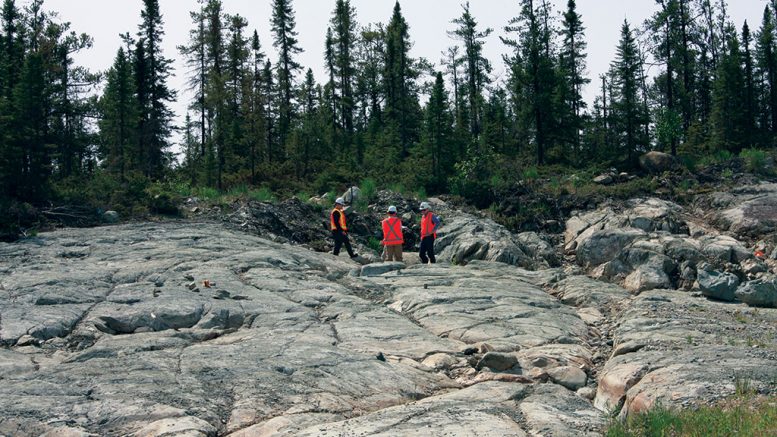Once in production, Dumont would be one of Canada’s largest base metal mines and one of the top-five sulphide nickel producers in the world, RNC Minerals (TSX: RNX) says.
The company has released an updated feasibility study on the fully permitted nickel-cobalt project, which contains the second-largest nickel reserves in the world (2.8 million tonnes, or 6.1 billion lb.), and the ninth-largest cobalt reserve (110,000 tonnes, or 243 million pounds).

A map of RNC Mineral’s Dumont project in Quebec.
Dumont, 60 km northeast of Rouyn-Noranda and 70 km northwest of Val-d’Or in Quebec’s Abitibi region, would operate for 30 years as an open-pit mine producing 1.2 million tonnes (2.6 billion lb.) nickel-in-concentrate.
Using a US$7.75 per lb. nickel price and a US$25 per lb. cobalt price, the study estimates Dumont would average free cash flow of US$201 million per year.
The mine would cost US$1 billion to build and put in production. On top of initial costs, expansion capital would require another US$601 million, and sustaining capital, another US$611 million, for total life-of-mine capital requirements of US$2.23 billion. Cash costs during the first phase (years one through seven) are estimated at US$2.98 per lb., and rise to US$3.30 per lb. in the second stage (years eight to 19), for an average cost of US$3.22 over the life-of-mine.
All-in sustaining costs add up to US$4.19 per lb. in phase one and US$3.80 per lb. over the life-of-mine.
The feasibility outlines a net present value at an 8% discount rate of US$920 million and 15.4% post-tax internal rate of return, based on nickel production in two phases. During stage one, nickel production in concentrate would reach 33,000 tonnes per year, expanding to 50,000 tonnes per year in phase two.

An outcrop at RNC Mineral’s Dumont nickel project in Quebec. Credit: RNC Minerals.
The average nickel concentrate grade over the 30-year mine life is estimated at 29%, which is a relatively high grade, RNC says, and makes it suitable for alternative paths to market, such as roasting — rather than traditional smelting and refining — to feed the stainless steel industry, or convert to nickel sulphate for the battery market.
After year 24, when open-pit operations would cease, 398 million tonnes of stockpiled mineralized material would support production for another six years.
The concentrator will process run-of-mine or stockpiled ore, with a conventional mill made up of a primary gyratory crusher, semi-autogenous grinding and ball mill, desliming, nickel flotation and magnetic separation of the flotation tails. The nickel concentrate will get thickened and filtered on-site before shipping by truck or rail to market.
Proven and probable reserves at Dumont add up to 1.03 billion tonnes grading 0.27% nickel, 107 parts per million cobalt, 0.019 gram palladium per tonne and 0.009 gram platinum per tonne, for 6.08 billion lb. nickel, 243 million lb. cobalt, 627,000 oz. palladium and 287,000 oz. platinum.
Dumont is located next to a rail line and a highway, and has a power line with enough capacity for the project’s construction phase. The company would need to build a 6 km rail spur and a 10 km power line feed.
The feasibility study improves upon its 2013 version through optimization in key areas, which include trolley assists on the main ramps that will trim cycle times and lower diesel consumption more than 35% (or 450 million litres over the 30-year mine life), and lower production rates during the pre-strip and first five years of operation. The study also includes concentrate roasting and conversion to ferronickel as the route to market nickel concentrate, and design improvements to tailings storage at mining rates for twice the milling capacity to speed up getting the highest-value ore to the process plant.
In addition to nickel and cobalt, Dumont’s mineralized material contains 44.9 million tonnes of magnetite at an average 4.37% grade. Test work in the earlier feasibility study found that 46% recoveries to a concentrate grading 63% iron could be achieved, and over the life-of-mine, Dumont could produce 24 million tonnes of magnetite concentrate, or 800,000 tonnes a year.

Delegates study high-grade rock samples from the Father’s Day vein at the Canadian Mining Symposium in London, U.K., in May 2019. Photo Credit: Martina Lang. www.martinalang.co.uk
Apart from Dumont, RNC Minerals owns 100% of the Beta Hunt gold mine in Western Australia, where it recently found high-grade gold in the Father’s Day Vein. RNC expects to finish a 40,000-metre drill program at Beta Hunt and update the mine’s resource estimate shortly.
At press time, RNC shares traded at 43.5¢ in a 52-week range of 7¢ to $1.18. The company has a $215-million market capitalization.


Be the first to comment on "RNC updates large Dumont nickel-cobalt project"